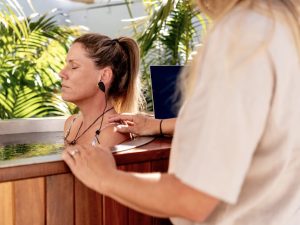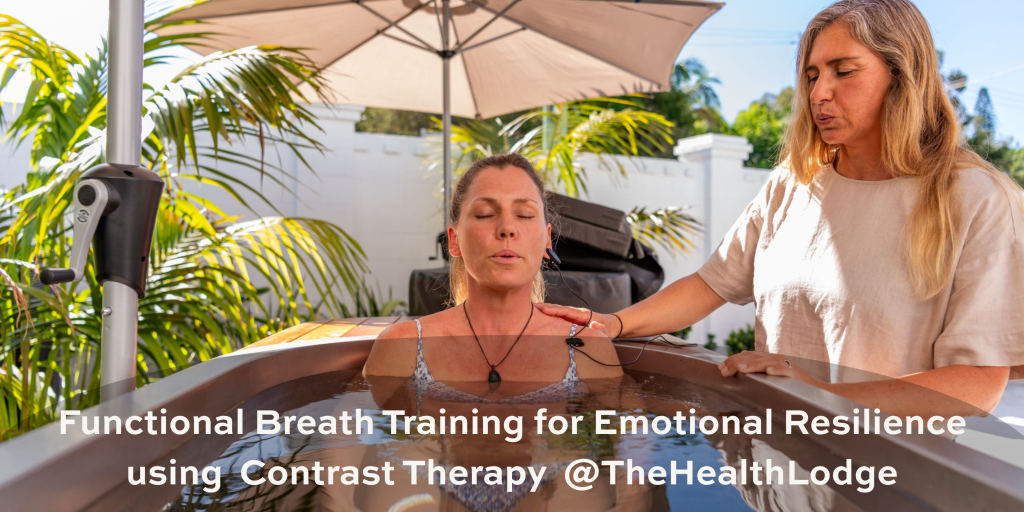 A three part article by Sally Howe – Functional Breath Coach, Simon Dubois – Psychologist and Reine DuBois – Clinical Naturopath.
A three part article by Sally Howe – Functional Breath Coach, Simon Dubois – Psychologist and Reine DuBois – Clinical Naturopath.
Sally Howe , Functional Breath Coach
These days, wellness is full of tools aimed at recovery—cold plunges, infrared saunas, magnesium baths. They’re often promoted as solutions for exhaustion, burnout, or chronic stress. But what if you’re not in any of those camps? What if you’re a woman who’s functioning well, managing her life, keeping up with responsibilities—and feeling okay?
This is where contrast therapy might surprise you. You don’t have to wait for the wheels to fall off to benefit from intentional heat and cold exposure. When used wisely, contrast therapy can help regulate your nervous system, shift emotional states, and build resilience—not just help you recover after burnout hits.
What Is Contrast Therapy, Really?
At its core, contrast therapy is the practice of alternating between heat and cold. That might mean a sauna followed by a cold plunge, or a hot shower followed by a 30-second rinse in cool water. This technique has long been used in sports recovery, with the theory being that the switch between vasodilation (from heat) and vasoconstriction (from cold) boosts circulation and helps flush out waste products in the body.
But the benefits go beyond the physical. That moment when you step into cold water and everything tightens? Then the release when you return to warmth? It’s not just your blood vessels reacting—it’s your whole nervous system recalibrating. Many people describe this as a “reset,” and with regular practice, it can enhance your emotional bandwidth and stress response over time.

You Don’t Have to Be Burnt Out to Benefit
Burnout isn’t just an all-or-nothing state. It develops over time and has levels. Think of it as a spectrum:
- Honeymoon phase – You’re enthusiastic and high-functioning, but stress is building.
- Onset of stress – You start noticing fatigue, distraction, or irritability.
- Chronic stress – These symptoms become more consistent, and you may feel emotionally drained.
- Burnout – Emotional exhaustion, detachment, and reduced performance set in.
- Habitual burnout – The symptoms become part of your everyday baseline, making recovery more complex.
Most high-functioning women sit somewhere around Stage 1 or 2. They’re still performing well but carrying subtle layers of stress—mental load, hormonal fluctuations, emotional fatigue—that can go unnoticed until they tip over the edge. This is the sweet spot where contrast therapy can be a preventative tool—not just a treatment.
The Nervous System Reset: A Case for Hot/Cold Exposure
Though research on contrast therapy in women is limited, what we do know about autonomic nervous system modulation suggests it may help build capacity for stress:
- Parasympathetic rebound after cold exposure promotes relaxation.
- Vagal nerve stimulation from both cold and heat supports emotional regulation.
- Improved interoception—your ability to feel and interpret body signals—helps with early stress detection.
- Mental training from controlled discomfort (especially cold) fosters psychological hardiness.
Even if you’re not in burnout, these benefits can help you stay calm, clear, and emotionally agile.
Why Emotional Resilience Matters?
Simon DuBois, Psychologist
Emotional resilience matters because it determines how well we can regulate ourselves under stress. In short, it increases our capacity to stay calm, think clearly, communicate effectively, and respond effectively under stress, rather than reacting impulsively, becoming overwhelmed, or making a situation worse for ourselves and those around us. We often feel frustrated and upset with ourselves when we lose our capacity to stay regulated. When we’re emotionally resilient, we’re more likely to meet life’s challenges with a sense of presence and agency, rather than getting stuck in cycles of reactivity or emotional shutdown.
Importantly, the best time to build emotional resilience is when we’re relatively well and not in crisis. Strengthening this capacity pre-emptively helps us ride life’s inevitable waves with more stability. It’s like taking our emotional body and nervous system to the gym or mediation retreat to practice and strengthen intensively the skill of emotional regulation so we have greater capacity in the everyday world. Practices like contrast therapy (alternating between hot and cold exposure) can play a meaningful role in building this capacity. These practices stretch our “window of tolerance”—the physiological and emotional zone within which we can remain regulated and engaged. The wider this window, the more capable we are of sitting with discomfort, staying present, and making effective choices under pressure.
Contrast therapy offers a way to explore our resilience in a controlled, physical environment. It teaches us how to notice the limits of our emotional tolerance and how to gently expand it using breathwork, self-talk, and awareness. Over time, this practice helps broaden our window of tolerance so we can more consistently meet stressors in a regulated way, bringing a steadier, more grounded presence into everyday life.
You can learn more about this topic in a video I recently produced:
Temperatures: What’s Safe and Effective for Women?
Here’s where things get nuanced. Unlike men, women tend to cool faster in cold water due to differences in body composition and thermoregulation. That means a cold plunge that feels invigorating for one person might feel shocking—or even overwhelming—for another, especially during certain phases of the menstrual cycle.
So what temperature is ideal? While there’s no universal recommendation for women in voluntary cold exposure, here’s what research and experience suggest:
- For contrast therapy, cold water around 12–14°C (53–57°F) for 1 minute has been used in studies, paired with hot water at 38–40°C (100–104°F) for the same duration. This is often repeated in 3–4 cycles.
- Gentle starts might involve cold showers or rinses without measuring exact temperatures—just enough to stimulate without shocking.
- If you’re curious about longer cold immersions, 18°C (64°F) is considered a moderate level of cold stress and has been tolerated for up to 90 minutes in research. But that’s more for advanced protocols—not necessary for resilience training.
The key takeaway? Start conservatively. For most women, a 30-second to 1-minute cold rinse after a warm shower is an excellent place to begin. You’ll still get a strong nervous system shift without overwhelming your body.
Contrast Therapy and Women’s Hormonal Health: A Cyclical Perspective
Reine DuBois, Clinical Naturopath
While contrast therapy is often celebrated for physical recovery and nervous system regulation, its relevance to women’s health—particularly in relation to hormonal fluctuations—is just beginning to emerge. Cold and heat exposure are not just physical stressors; they’re also tools that interact with our internal rhythms. For women, those rhythms shift predictably across the menstrual cycle and more dramatically during menopause, creating unique opportunities (and limitations) for therapeutic contrast bathing.
Throughout the menstrual cycle, the body’s thermal sensitivity and stress reactivity change in response to hormonal shifts. During the early follicular phase (including menstruation), estrogen is low and the body’s core temperature is also reduced. This is a time when the body may be more sensitive to cold, but interestingly, many women report that cold immersion alleviates cramps, bloating, and emotional tension—likely via vasoconstriction, inflammation reduction, and endorphin release (Swim England, 2022).
As estrogen rises leading up to ovulation, energy and resilience increase. This phase is considered ideal for more intense cold exposure—tolerance is often higher, and the nervous system tends to respond positively. Standard contrast cycles (hot 38–40°C and cold 12–14°C for 1 minute, repeated 3–4 times) are generally well tolerated here.
The luteal phase, where progesterone rises, tells a different story. Progesterone increases core temperature and reduces heat tolerance, making women more sensitive to both cold and heat. Many women find shorter cold durations more tolerable during this phase (e.g. 30–60 seconds), paired with longer warming periods to avoid unnecessary stress. This is also when PMS symptoms may peak—cold exposure may support mood, circulation, and sleep if applied gently.
Emerging evidence from a large survey of women participating in cold water swimming reported that many use the practice to reduce menstrual and premenstrual symptoms, including:
- Anxiety (46.7%)
- Mood swings (37.7%)
- Irritability (37.6%)
- Sleep difficulties (21.0%)
(Source: ‘Outdoor Swimming Society’, 2022)
In menopause, where estrogen and progesterone steadily decline, cold water immersion has shown promise in helping manage symptoms like hot flushes, anxiety, depression, and night sweats. In a study of 785 women, cold water swimming significantly improved:
- Hot flushes (30.3%)
- Mood swings (34.5%)
- Low mood and depression (31.1%, 28.0%)
- Aches and pains (18.5%)
(Source: Harper et al., 2023, Post-Reproductive Wellbeing Journal)
Mechanistically, these outcomes may relate to:
- HPA axis regulation, improving the body’s stress resilience
- Vagal stimulation from cold and heat, supporting parasympathetic tone
- Endorphin release and pain modulation
- Improved interoception, helping women track subtle physiological and emotional cues
The takeaway? Women benefit most when contrast bathing is responsive, not prescriptive. Tune into your cycle. Begin with short exposures. Modify based on tolerance, especially in the luteal or menopausal phases. And view the practice not as punishment, but as a rhythmical reset—anchoring your nervous system in a deeper relationship with your body.
References
- Harper, J. et al. (2023). Cold Water Immersion for Menopausal Symptom Relief: A Survey of 785 Women. Post-Reproductive Wellbeing Journal.
- Outdoor Swimming Society. (2022). Menstrual Health and Cold Water: A Survey Report.
- Swim England. (2022). Women and Cold Water Swimming: Health Impacts Survey.
More Than Just a Trend—It’s a Practice
When used intentionally, contrast therapy becomes a tool for daily transition and self-regulation. It might be how you mark the end of the workday, reset after a hard conversation, or clear the fog of emotional overwhelm. Over time, it teaches your nervous system how to shift—how to come back to balance, again and again.
You don’t need extreme temperatures, ice baths, or long durations to reap the benefits. You need consistency. A couple of minutes a few times a week, paired with slow nasal breathing and self-awareness, can shift your baseline.
Final Thoughts
You don’t have to be exhausted to take care of your energy. You don’t need a diagnosis to start building resilience. With contrast therapy, you’re not just reacting to stress—you’re conditioning your body and mind to recover faster, stay balanced longer, and tune into what you need.
It’s not about becoming unbreakable. It’s about staying responsive, aware, and adaptable—so you can keep showing up in your life with clarity, strength, and softness, all at once.

